Using Excimer Laser for Manufacturing Stimuli Responsive Membranes
Abstract
1. Introduction
2. Excimer Lasers
3. Pulsed Laser Polymerization (PLP)
4. Stimuli Responsive Hydrogels
5. Sample Experiments and Results
6. Conclusions
Funding
Conflicts of Interest
References
- Guillen, G.R.; Pan, Y.; Li, M.; Hoek, E.M.V. Preparation and characterization of membranes formed by nonsolvent induced phase separation: A review. Ind. Eng. Chem. Res. 2011, 50, 3798–3817. [Google Scholar] [CrossRef]
- Kollia, E.; Mastrotheodoros, G.; Kosma, V.; Beltsios, K.G. Single step fabrication of polymer/silicate porous composite membranes via water-glass induced phase inversion. Polym. Technol. Mater. 2019, 58, 957–966. [Google Scholar] [CrossRef]
- Macedo Baldo, L.G.; Lenzi, M.K.; Eiras, D. Water vapor permeation and morphology of polysulfone membranes prepared by phase inversion. Polimeros 2020, 30, 1–8. [Google Scholar] [CrossRef]
- Kausar, A. Phase inversion technique-based polyamide films and their applications: A comprehensive review. Polym. Technol. Eng. 2017, 56, 1421–1437. [Google Scholar] [CrossRef]
- Singh, B.; Kochkodan, V.; Hashaikeh, R.; Hilal, N. A review on membrane fabrication: Structure, properties and performance relationship. Desalination 2013, 326, 77–95. [Google Scholar] [CrossRef]
- Tabatabaei, S.H.; Carreau, P.J.; Ajji, A. Microporous membranes obtained from PP/HDPE multilayer films by stretching. J. Memb. Sci. 2009, 345, 148–159. [Google Scholar] [CrossRef]
- Zhu, W.; Zhang, X.; Zhao, C.; Wu, W.; Hou, J.; Xu, M. A novel polypropylene microporous film. Polym. Adv. Technol. 1996, 7, 743–748. [Google Scholar] [CrossRef]
- Kristin Trommer, B.M.R. Nonrigid microporous PVC sheets: Preparation and properties. J. Appl. Polym. Sci. 2010, 115, 2119–2126. [Google Scholar] [CrossRef]
- Marcel, M. Marcel Mulder-Basic Principles of Membrane Technology, 2nd ed.; Springer: New York, NY, USA, 1996. [Google Scholar]
- Kaya, D.; Keçeci, K. Track-etched nanoporous polymer membranes as sensors: A review. J. Electrochem. Soc. 2020, 167, 037543. [Google Scholar] [CrossRef]
- Ma, T.; Janot, J.M.; Balme, S. Track-etched nanopore/membrane: From fundamental to applications. Small Methods 2020, 4, 2000366. [Google Scholar] [CrossRef]
- Apel, P. Track etching technique in membrane technology. Radiat. Meas. 2001, 34, 559–566. [Google Scholar] [CrossRef]
- Li, W.; Sancaktar, E. Patterned perforation of polyester films by excimer laser ablation. J. Laser Appl. 2017, 29, 012016. [Google Scholar] [CrossRef]
- Li, W.; Sancaktar, E. Orderly Perforation of Polyester Films by Excimer Laser. In Proceedings of the ASME 2015 International Design Engineering Technical Conferences & Computers and Information in Engineering Conference, Boston, MA, USA, 2–5 August 2015. DETC2015-47731. [Google Scholar]
- Catiker, E.; Stakleff, K.S.; Carr, K.B.; Sancaktar, E. Laser perforated polymer films for possible use in tissue engineering. Surf. Innov. 2016, 4, 23–32. [Google Scholar] [CrossRef]
- Ahn, D.U.; Sancaktar, E. Fabrication of block copolymer nanotemplates by one-step matrix-assisted photothermal excimer laser ablation. Curr. Nanosci. 2009, 5, 324–334. [Google Scholar] [CrossRef]
- Ahn, D.U.; Sancaktar, E. Direct fabrication of high density polymer nano-dots by excimer laser irradiation of block copolymer masks. In Polymer Surface Modification: Relevance to Adhesion; Mittal, K.L., Ed.; VSP: Leiden, The Netherlands, 2009; Volume 5, pp. 155–175. [Google Scholar]
- Ahn, D.U.; Sancaktar, E. Fabrication of well-defined block copolymer nano-cylinders by self-assembly and their use in high-density nano-dots fabrication by one-step excimer laser ablation. In NanoTR IV Proceedings; Unlu, H., Ed.; Istanbul Technical University: Istanbul, Turkey, 2008; p. 169. [Google Scholar]
- Ahn, D.U.; Sancaktar, E. Fabrication of high density silicon nano-dots by excimer laser irradiation on block copolymer masks. In Proceedings of the ASME 2007 International Design Engineering Technical Conferences & Computers and Information in Engineering Conference on Reliability, Stress Analysis and Failure Prevention, Las Vegas, NV, USA, 4–7 September 2007; Sancaktar, E., Ed.; ASME: New York, NY, USA, 2009. DETC2007-35650. [Google Scholar]
- Ahn, D.U.; Sancaktar, E. Perpendicularly aligned, size-and spacing-controlled nanocylinders by molecular-weight adjustment of a homopolymer blended in an asymmetric triblock copolymer. Adv. Funct. Mater. 2006, 16, 1950–1958. [Google Scholar] [CrossRef]
- Ahn, D.U.; Sancaktar, E. Fabrication of well-defined block copolymer nano-cylinders by controlling the thermodynamics and kinetics involved in block copolymer self-assembly. Soft Matter 2008, 4, 1454–1466. [Google Scholar] [CrossRef]
- Ahn, D.U.; Sancaktar, E. Temperature-dependent phase behaviors in cylinder-forming block copolymers. Int. J. Mol. Sci. 2009, 10, 2169–2189. [Google Scholar] [CrossRef]
- Ahn, D.U.; Sancaktar, E. Control of block copolymer cylinder-phase orientation by homopolymer blending. In Polymer Surface Modification: Relevance to Adhesion; Mittal, K.L., Ed.; VSP: Leiden, The Netherlands, 2009; Volume 5, pp. 341–380. [Google Scholar]
- Tiwari, A.; Sancaktar, E. Poly(N-isopropylacrylamide) grafted temperature responsive PET membranes: An ultrafast method for membrane processing using KrF excimer laser at 248 nm. J. Membr. Sci. 2018, 552, 357–366. [Google Scholar] [CrossRef]
- Tiwari, A.; Sancaktar, E. Poly(N-isopropylacrylamide) grafting solution parameters for controlling temperature responsiveness in PET membranes fabricated using 248 nm KrF excimer laser. Eur. Polym. J. 2018, 103, 220–227. [Google Scholar] [CrossRef]
- Wu, L.; Sancaktar, E. Effect of PET support membrane thickness on water permeation behavior of thermally responsive PNIPAM-g-PET membranes. J. Membr. Sci. 2020, 610, 118304. [Google Scholar] [CrossRef]
- Patil, R.; Sancaktar, E. Fabrication of pH-responsive polyimide polyacrylic acid smart gating membranes: Ultrafast method using 248 nm krypton fluoride excimer laser. ACS Appl. Mater. Interfaces 2021, 13, 24431–24441. [Google Scholar] [CrossRef]
- Patil, R.; Sancaktar, E. Effect of solution parameters on pH-response of polyacrylic acid grafted polyimide smart membrane fabricated using 248 nm krypton fluoride excimer laser. Polymer 2021, 233, 124181. [Google Scholar] [CrossRef]
- Patil, R.; Narayanan, A.; Tantisuwanno, C.; Sancaktar, E. Immobilization of glucose oxidase on pH-responsive polyimide-polyacrylic acid smart membranes fabricated using 248 nm KrF excimer laser for drug delivery. Biointerface Res. Appl. Chem. 2023, 13, 11. [Google Scholar] [CrossRef]
- Basting, D.; Marowsky, G. Introductory remarks. In Excimer Laser Technology; Basting, D., Marowsky, G., Eds.; Springer: New York, NY, USA, 2005; pp. 1–7. [Google Scholar] [CrossRef]
- Brown, M.S.; Arnold, C.B. Fundamentals of laser-material interaction and application to multiscale surface modification. In Laser Precision Microfabrication; Sugioka, K., Meunier, M., Piqué, A., Eds.; Springer: New York, NY, USA, 2010; pp. 91–120. [Google Scholar] [CrossRef]
- Srinivasan, R. Ablation of polymers and biological tissue by ultraviolet lasers. Science 1986, 234, 559–565. [Google Scholar] [CrossRef]
- Sancaktar, E.; Lu, H. The effects of excimer laser irradiation at 248 nm on the surface mass loss and thermal properties of PS, ABS, PA6, and PC polymers. J. Appl. Polym. Sci. 2006, 99, 1024–1037. [Google Scholar] [CrossRef]
- Sancaktar, E.; Negandhi, N.; Adwani, S. Evaluation of processing effects in injection molded amorphous and crystalline thermoplastics using excimer laser. J. Appl. Polym. Sci. 2006, 101, 258–268. [Google Scholar] [CrossRef]
- Sancaktar, E.; Kim, J.D. Calculation of excimer laser induced temperature profiles in PET, PBT, and PS polymer films. In Proceedings of the ASME 2005 International Design Engineering Technical Conferences & Computers and Information in Engineering Conference on Reliability, Stress Analysis and Failure Prevention, Long Beach, CA, USA, 24–28 September 2005; Sancaktar, E., Ed.; ASME: New York, NY, USA, 2008. DETC2005-84532. [Google Scholar]
- Lazare, S.; Granier, V. Ultraviolet laser photoablation of polymers: A review and recent results. Laser Chem. 1989, 10, 25–40. [Google Scholar] [CrossRef]
- Mahan, G.D.; Cole, H.S.; Liu, Y.S.; Philipp, H.R. Theory of polymer ablation. Appl. Phys. Lett. 1988, 53, 2377–2379. [Google Scholar] [CrossRef]
- Sutcliffe, E.; Srinivasan, R. Dynamics of UV laser ablation of organic polymer surfaces. J. Appl. Phys. 1986, 60, 3315–3322. [Google Scholar] [CrossRef]
- Cole, H.S.; Liu, Y.S.; Philipp, H.R. Dependence of photoetching rates of polymers at 193 nm on optical absorption depth. Appl. Phys. Lett. 1986, 48, 76–77. [Google Scholar] [CrossRef]
- Garza-Lopez, T.E.; Sancaktar, E.; Mittal, K.L. Excimer lasers: How they work and ablate. Vac. Tech. Coat. 2002, 3, 52–59. [Google Scholar]
- Nitschke, A.; Riemann, L.; Kollenbach, L.; Braun, V.; Buback, M.; Vana, P. Investigation into the kinetics of n-pentyl methacrylate radical polymerization. Macromol. Chem. Phys. 2020, 221, 1900345. [Google Scholar] [CrossRef]
- Olaj, O.F.; Schnöll-Bitai, I. Laser-flash-initiated polymerization as a tool for evaluating (individual) kinetic constants of free-radical polymerization-5. Complete analysis by means of a single experiment. Eur. Polym. J. 1989, 25, 635–641. [Google Scholar] [CrossRef]
- Olaj, O.F.; Bitai, I.; Hinkelmann, F. The direct determination of the rate constant of chain propagation. Makromol. Chem. 1987, 288, 1689–1702. [Google Scholar] [CrossRef]
- van Herk, A.M. Pulsed initiation polymerization as a means of obtaining propagation rate coefficients in free-radical polymerizations. J. Macromol. Sci. Part C Polym. Rev. 1997, 37, 633–648. [Google Scholar] [CrossRef]
- Beuermann, S. Solvent influence on propagation kinetics in radical polymerizations studied by pulsed laser initiated polymerizations. Macromol. Rapid Commun. 2009, 30, 1066–1088. [Google Scholar] [CrossRef]
- O’Shaughnessy, B.; Vavylonis, D. Pulsed laser polymerization at low conversions: Broadening and chain transfer effects. Macromol. Theory Simul. 2003, 12, 401–412. [Google Scholar] [CrossRef]
- Lacík, I.; Beuermann, S.; Buback, M. Aqueous phase size-exclusion-chromatography used for PLP-SEC studies into free-radical propagation rate of acrylic acid in aqueous solution. Macromolecules 2001, 34, 6224–6228. [Google Scholar] [CrossRef]
- Lyons, R.A.; Hutovic, J.; Piton, M.C.; Christie, D.I.; Clay, P.A.; Manders, B.G.; Kable, S.H.; Gilbert, R.G. Pulsed-laser polymerization measurements of the propagation rate coefficient for butyl acrylate. Macromolecules 1996, 29, 1918–1927. [Google Scholar] [CrossRef]
- Kuchta, F.D.; Van Herk, A.M.; German, A.L. Propagation kinetics of acrylic and methacrylic acid in water and organic solvents studied by pulsed-laser polymerization. Macromolecules 2000, 33, 3641–3649. [Google Scholar] [CrossRef]
- Barner-Kowollik, C.; Günzler, F.; Junkers, T. Pushing the limit: Pulsed laser polymerization of n-butyl acrylate at 500 Hz. Macromolecules 2008, 41, 8971–8973. [Google Scholar] [CrossRef]
- Beuermann, S.; Buback, M. Rate coefficients of free-radical polymerization deduced from pulsed laser experiments. Prog. Polym. Sci. 2002, 27, 191–254. [Google Scholar] [CrossRef]
- Lacík, M.; Stach, P.; Kasák, V.; Semak, L.; Uhelská, A.; Chovancová, G.; Reinhold, P.; Kilz, G.; Delaittre, B.; Charleux, I.; et al. SEC analysis of poly(acrylic acid) and poly(methacrylic acid). Macromol. Chem. Phys. 2015, 216, 23–37. [Google Scholar] [CrossRef]
- Van Herk, A.M. Pulsed initiation polymerization applied to acrylate monomers: Sources of experimental failure. Macromol. Rapid Commun. 2001, 22, 687–689. [Google Scholar] [CrossRef]
- Arzamendi, G.; Plessis, C.; Leiza, J.R.; Asua, J.M. Effect of the intramolecular chain transfer to polymer on PLP/SEC experiments of alkyl acrylates. Macromol. Theory Simul. 2003, 12, 315–324. [Google Scholar] [CrossRef]
- Kubota, K.; Fujishige, S.; Ando, I. Solution properties of poly(N-isopropylacrylamide) in water. Polym. J. 1990, 22, 15–20. [Google Scholar] [CrossRef]
- Kubota, K.; Fujishige, S.; Ando, I. Single-chain transition of poly(N-isopropylacrylamide) in water. J. Phys. Chem. 1990, 94, 5154–5158. [Google Scholar] [CrossRef]
- Gómez-de-Mariscal, E.; García-López-de-Haro, C.; Ouyang, W.; Donati, L.; Lundberg, E.; Unser, M.; Muñoz-Barrutia, A.; Sage, D. DeepImageJ: A user-friendly environment to run deep learning models in ImageJ. Nat. Methods 2021, 18, 1192–1195. [Google Scholar] [CrossRef]
- Sancaktar, E.; Lu, H.; Sunthonpagasit, N. Effects of excimer laser treatment on self- adhesion strength of some commodity (PS, PP) and engineering (ABS) plastics. In Laser Surface Modification and Adhesion; Mittal, K.L., Bahners, T., Eds.; Scrivener Publishing (Wiley): Beverly, MA, USA, 2015; pp. 55–101. [Google Scholar]
- Sancaktar, E.; Sunthonpagasit, N. Surface modification of polypropylene for improved adhesion. In Polymer Surface Modification: Relevance to Adhesion; Mittal, K.L., Ed.; VSP: Leiden, The Netherlands, 2004; Volume 3, pp. 285–324. [Google Scholar]
- Sancaktar, E.; Basan, S. Excimer laser treatment of nylon fibers for improved adhesion to vulcanized natural rubber. In Proceedings of the ASME 2020 International Design Engineering Technical Conferences & Computers and Information in Engineering Conference, Virtual, 17–19 August 2020; ASME: New York, NY, USA, 2020. DETC2020-22435. [Google Scholar]
- Sancaktar, E.; Lipshitz, H.; Babu, S.V.; Zhang, E.; D’Couto, G.C. The effects of laser radiation at 248 nm on the surface characteristics and joint properties of aluminum adherends. J. Adhes. 1995, 50, 103–133. [Google Scholar] [CrossRef]
- Lipshitz, H.; Stillwell, R.; Sancaktar, E. On relationship between the topographic characteristics of aluminum adherends and their joint properties. In Imaging and Illumination for Metrology and Inspection, SPIE Proceedings; Svetkoff, P.J., Ed.; SPIE: Bellingham, WA, USA, 1994; Volume 2348, pp. 99–112. [Google Scholar]
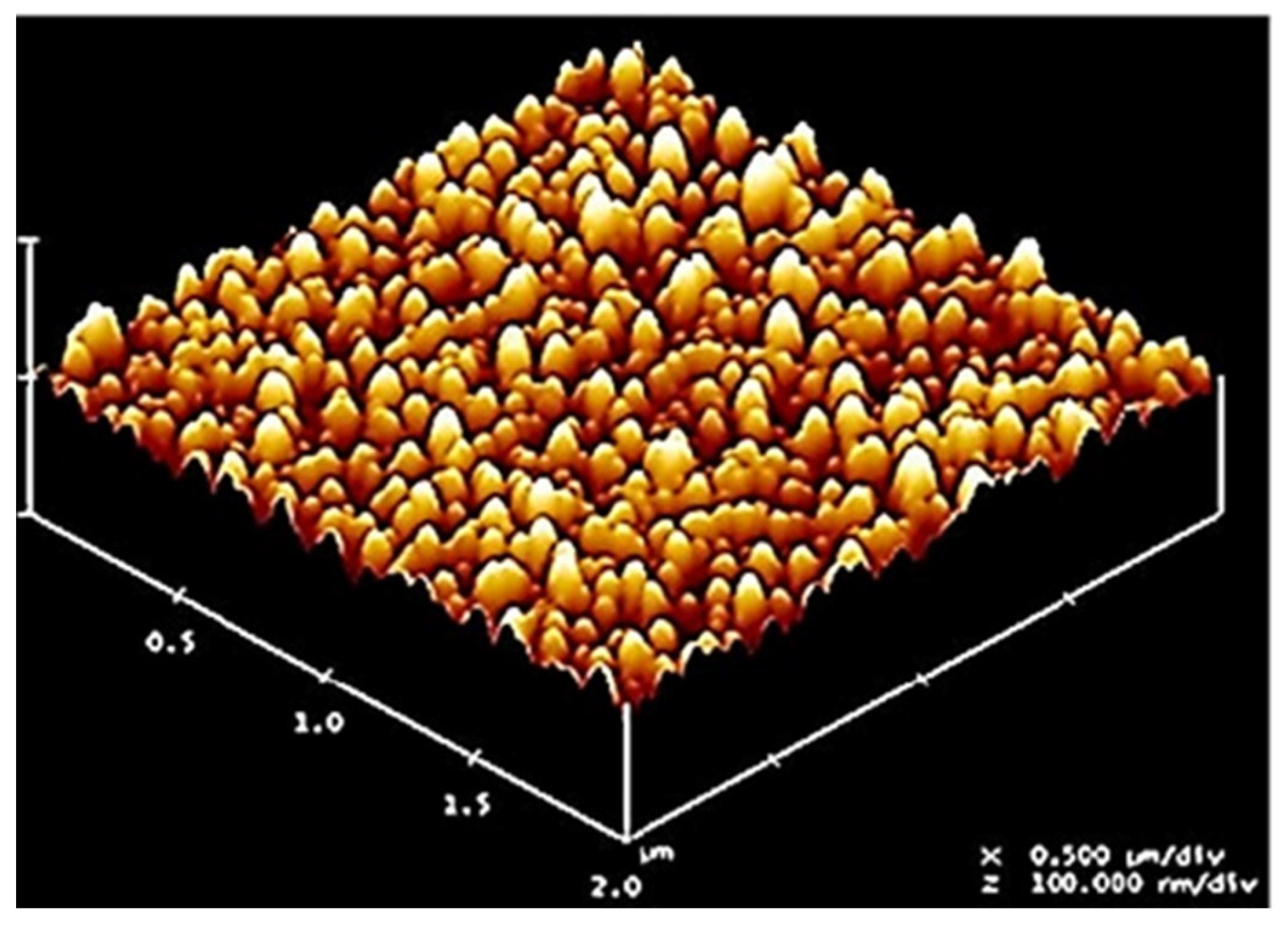
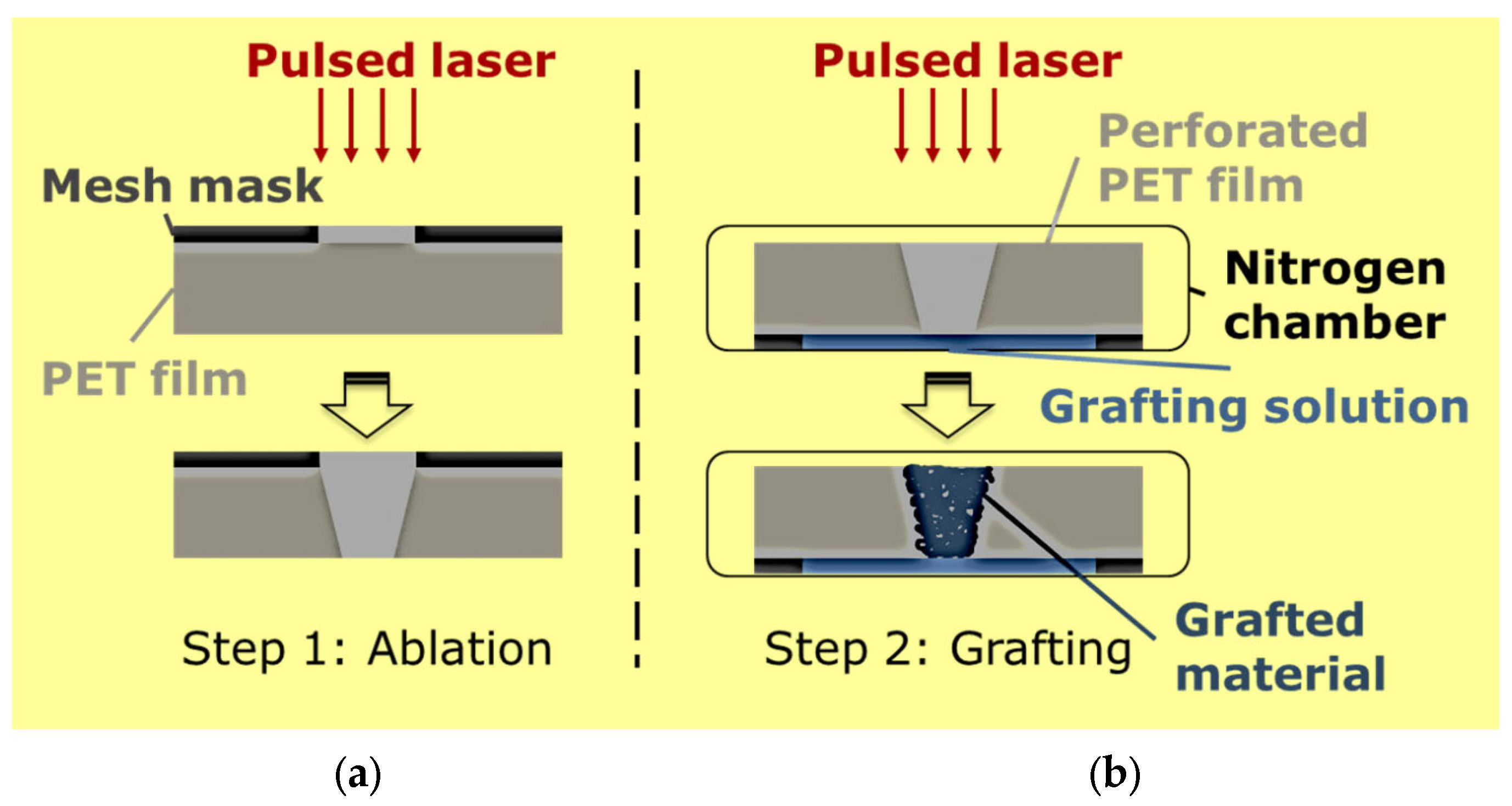
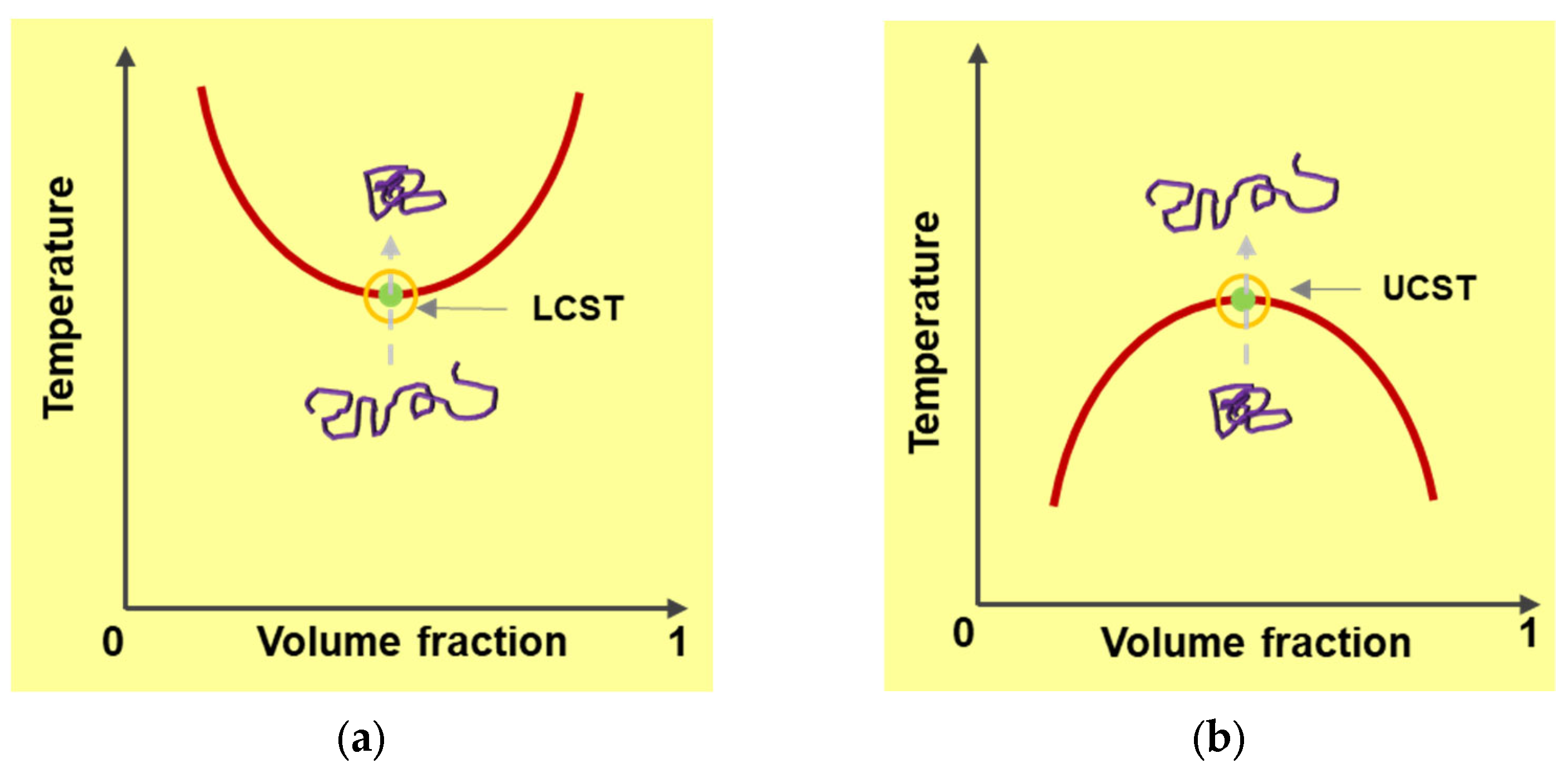
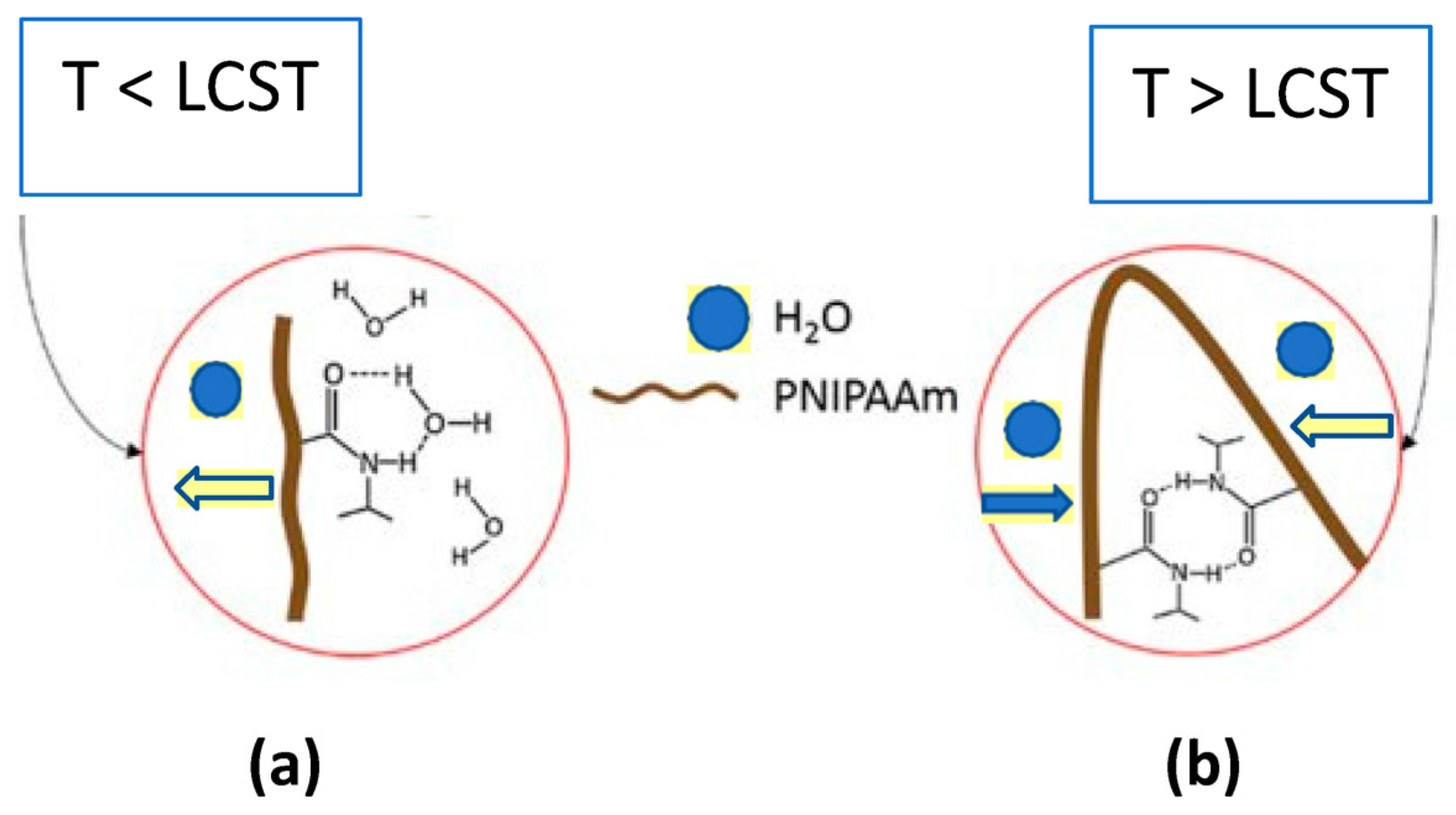
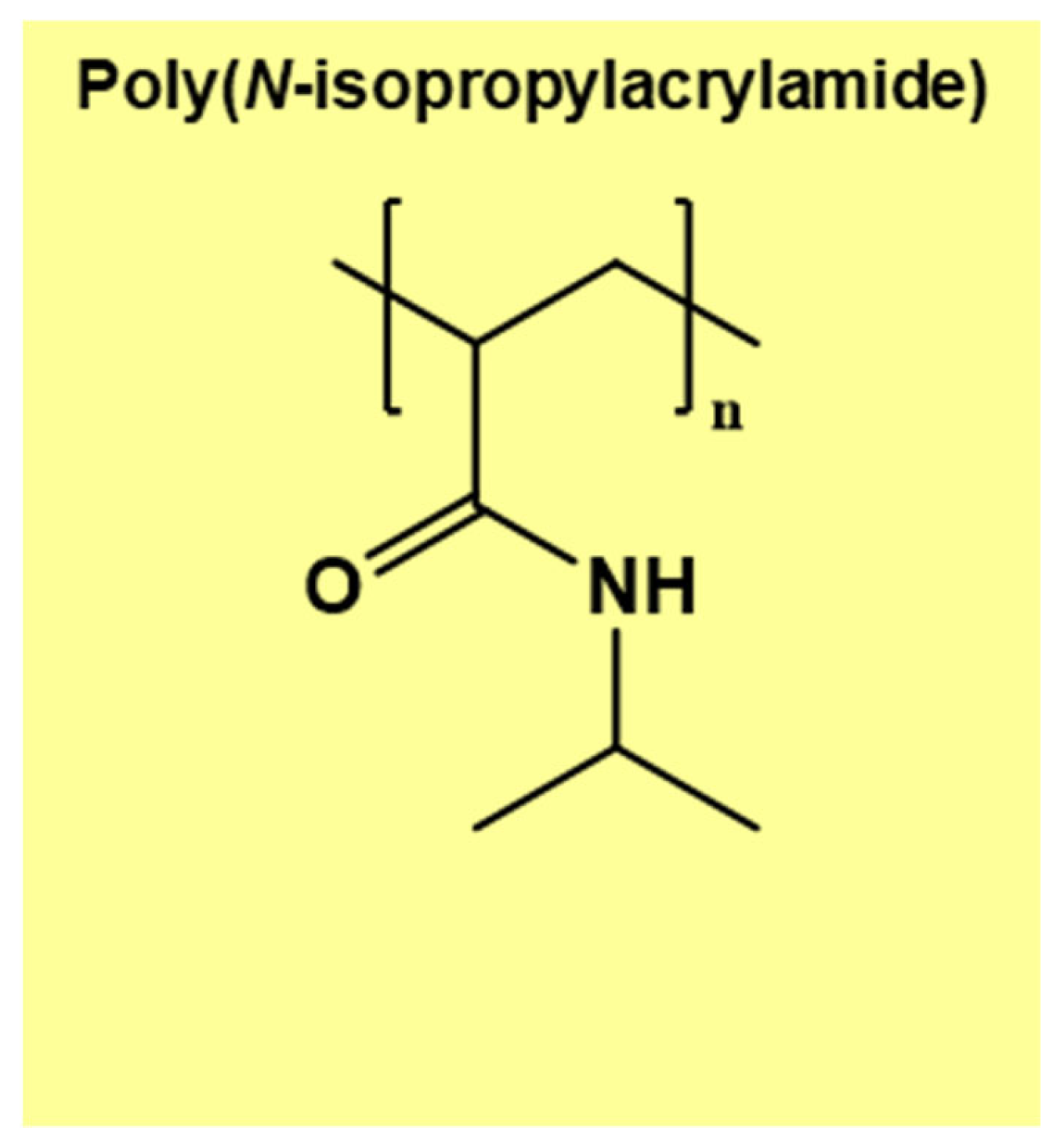

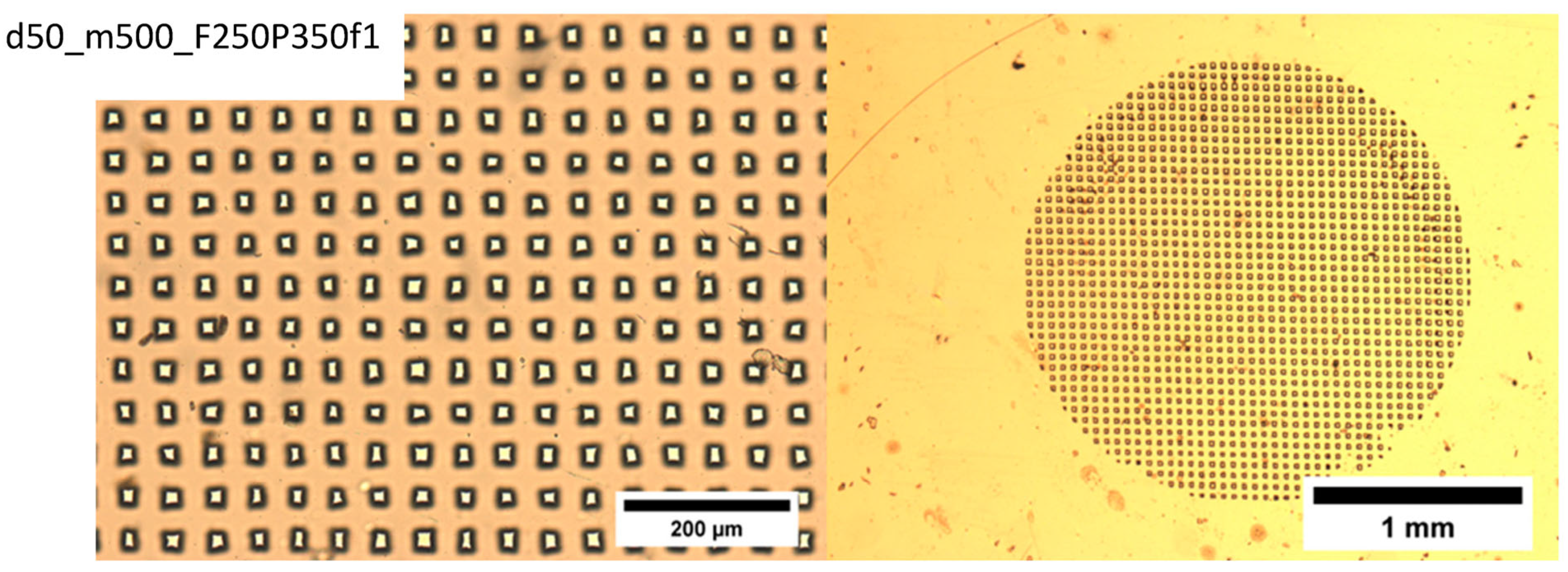
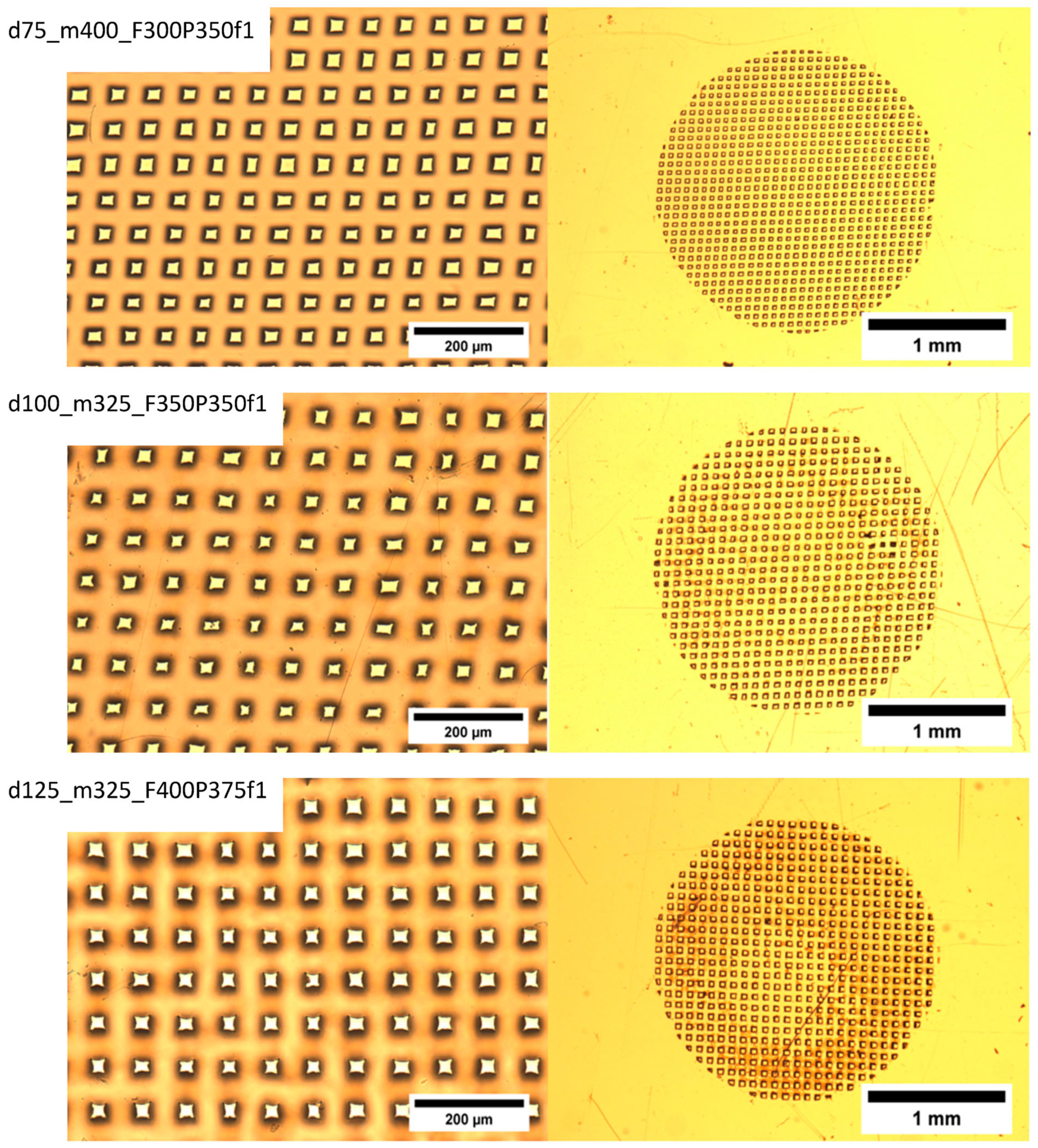

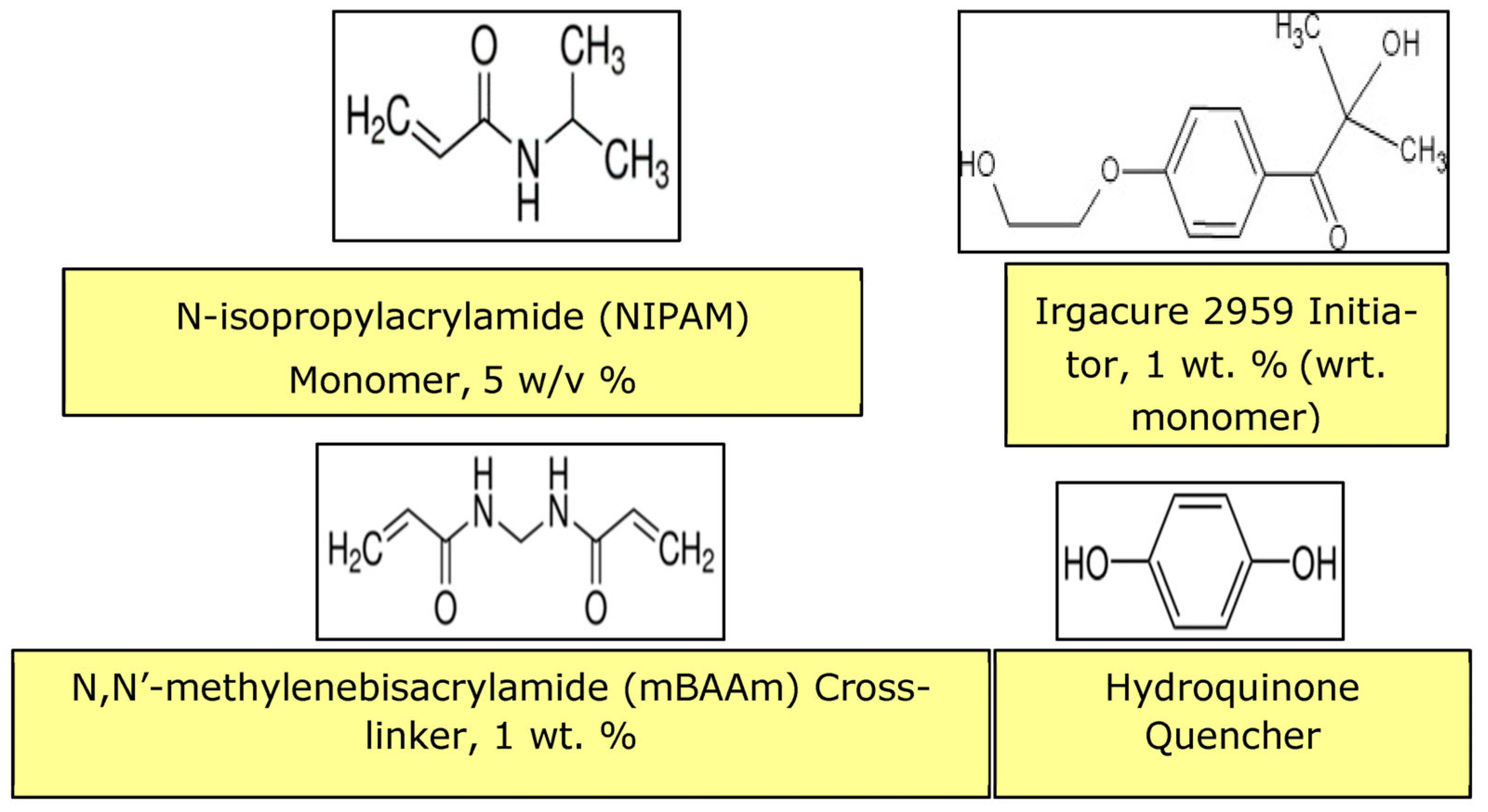
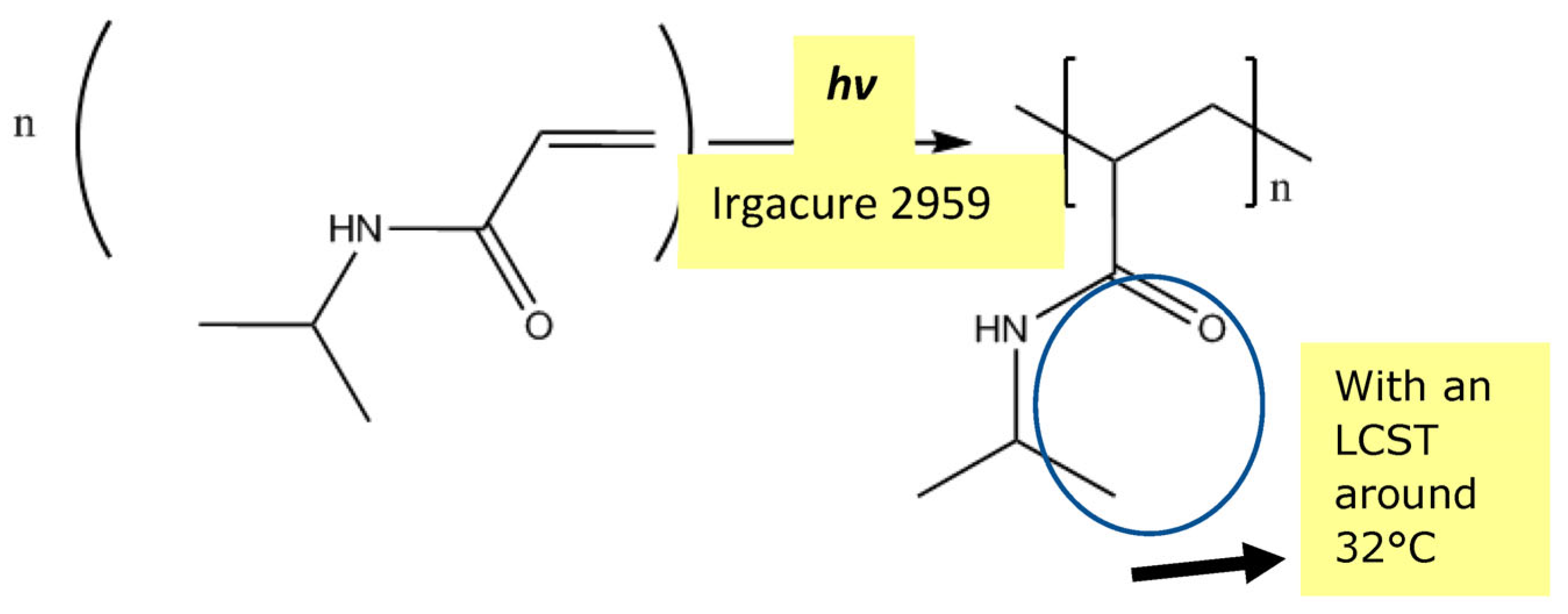
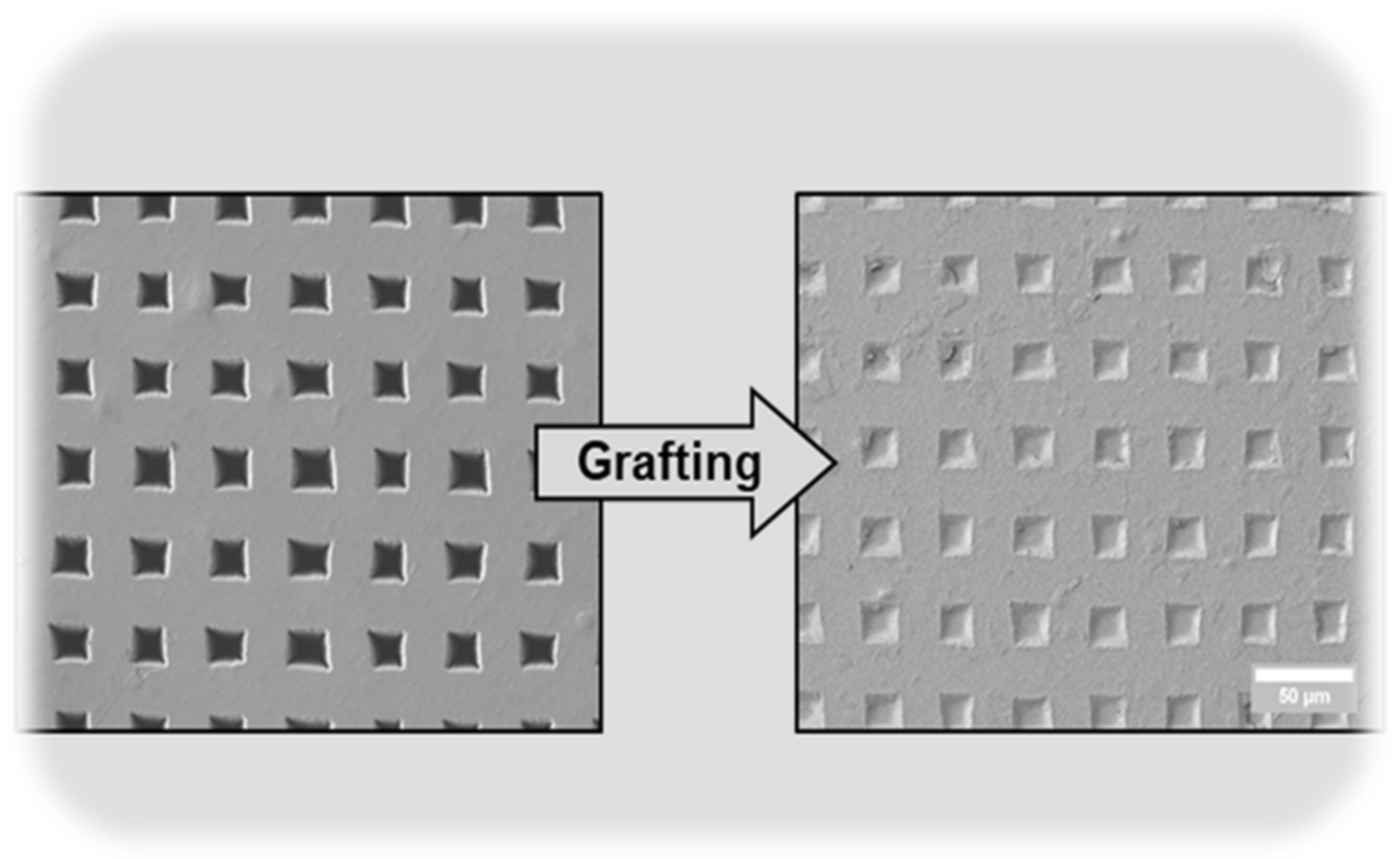
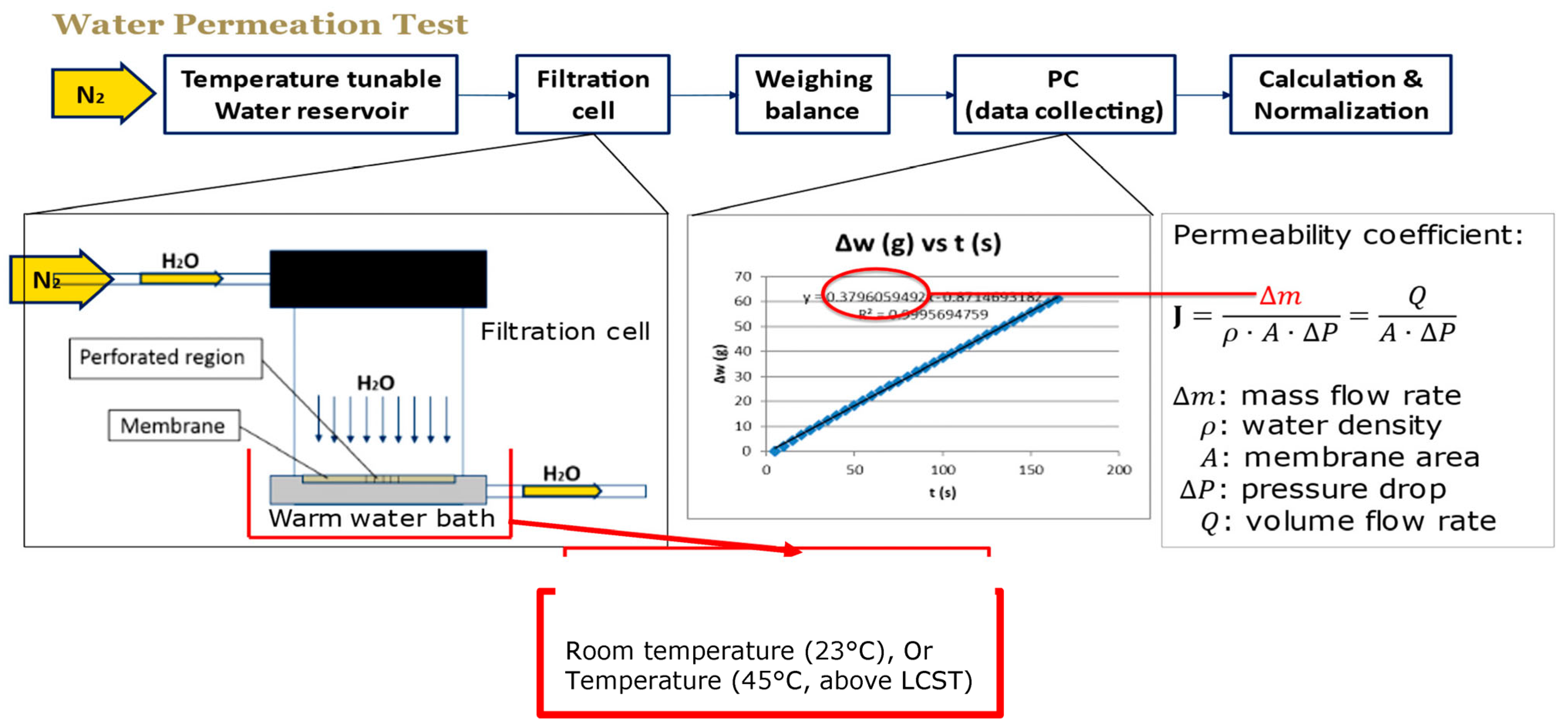
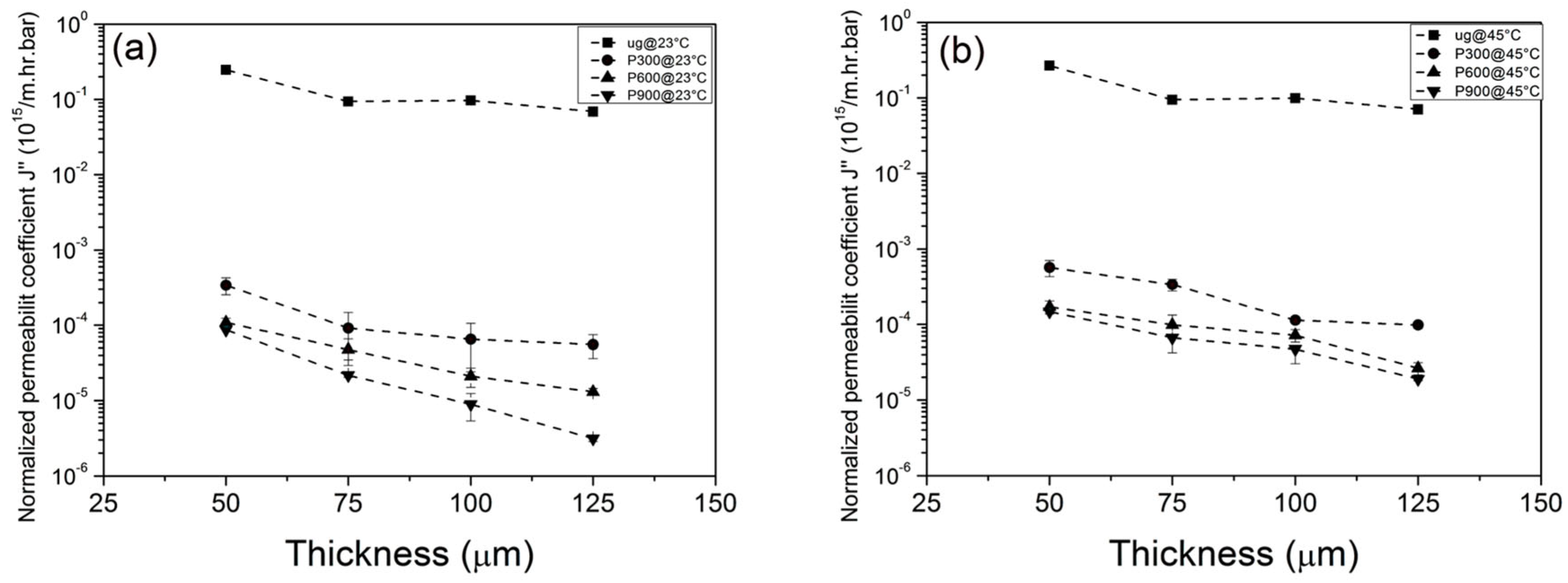
| Grafting Condition | Operation Time (s) |
|---|---|
| F5P300f25 | 12 |
| F5P600f25 | 24 |
| F5P900f25 | 36 |
Disclaimer/Publisher’s Note: The statements, opinions and data contained in all publications are solely those of the individual author(s) and contributor(s) and not of MDPI and/or the editor(s). MDPI and/or the editor(s) disclaim responsibility for any injury to people or property resulting from any ideas, methods, instructions or products referred to in the content. |
© 2023 by the author. Licensee MDPI, Basel, Switzerland. This article is an open access article distributed under the terms and conditions of the Creative Commons Attribution (CC BY) license (https://creativecommons.org/licenses/by/4.0/).
Share and Cite
Sancaktar, E. Using Excimer Laser for Manufacturing Stimuli Responsive Membranes. Membranes 2023, 13, 398. https://doi.org/10.3390/membranes13040398
Sancaktar E. Using Excimer Laser for Manufacturing Stimuli Responsive Membranes. Membranes. 2023; 13(4):398. https://doi.org/10.3390/membranes13040398
Chicago/Turabian StyleSancaktar, Erol. 2023. "Using Excimer Laser for Manufacturing Stimuli Responsive Membranes" Membranes 13, no. 4: 398. https://doi.org/10.3390/membranes13040398
APA StyleSancaktar, E. (2023). Using Excimer Laser for Manufacturing Stimuli Responsive Membranes. Membranes, 13(4), 398. https://doi.org/10.3390/membranes13040398






